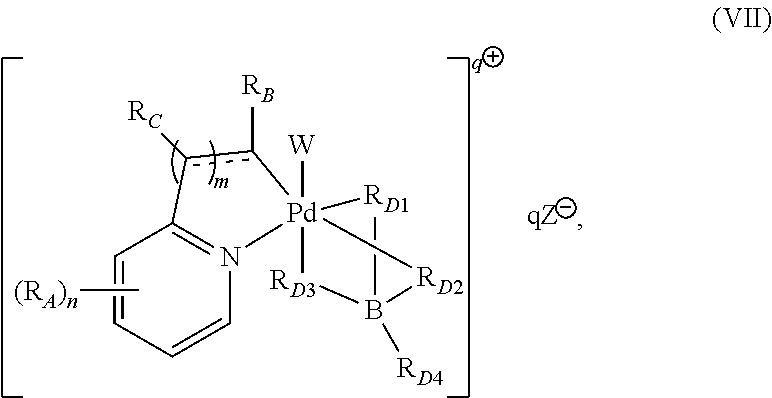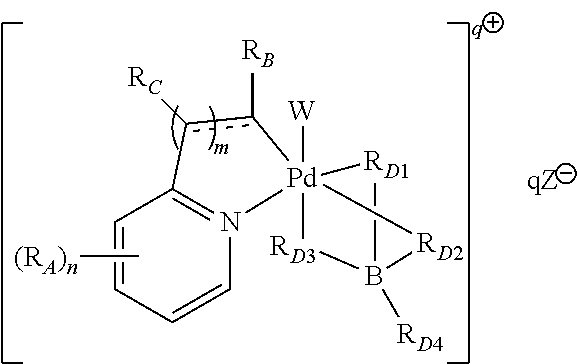High-valent palladium fluoride complexes and uses thereof
a technology of palladium fluoride and complexes, which is applied in the field of high-valent palladium fluoride complexes, can solve the problems of difficult fluorination of other organic compounds, difficult carbon-fluorine bonds, and difficult c—f bond formation, and achieve no broadly applicable solutions
- Summary
- Abstract
- Description
- Claims
- Application Information
AI Technical Summary
Benefits of technology
Problems solved by technology
Method used
Image
Examples
example 1
Synthesis of Palladium(IV) Pyridine Complexes
Benzo[h]quinolinyl palladium acetate dimer (1)
[0328]
[0329]To benzo[h]quinoline (1.00 g, 5.58 mmol, 1.00 equiv) in MeOH (75 mL) at 23° C. was added Pd(OAc)2 (1.25 g, 5.58 mmol, 1.00 equiv). After eight hours, the precipitate was isolated by filtration and washed sequentially with MeOH (50 mL) and Et2O (50 mL). The solid was dissolved in CH2Cl2 (250 mL) and filtered through a plug of Celite. Solvent was removed in vacuo to afford 1.68 g of the title compound as a yellow solid (88% yield). NMR Spectroscopy: 1H NMR (500 MHz, CDCl3, 23° C., δ): 7.80 (dd, J=5.5 Hz, 1.5 Hz, 1H), 7.43 (dd, J=8.0 Hz, 1.5 Hz, 1H), 7.24-7.18 (m, 3H), 7.08 (dd, J=7.0 Hz, J=1.5 Hz, 1H), 6.97 (d, J=9.0 Hz, 1H), 6.46 (dd, J=7.5 Hz, 5.0 Hz, 1H), 2.38 (s, 3H). 13C NMR (125 MHz, CDCl3, 23° C., δ): 182.5, 153.2, 148.9, 148.8, 140.0, 135.3, 132.4, 129.0, 127.9, 127.7, 125.0, 122.9, 122.1, 119.8, 25.2.
Potassium tetra(1H-pyrazol-1-yl)borate
[0330]
[0331]As solids, KBH4 (6.00 g, ...
example 2
Synthesis of Palladium(IV) Fluoride Complexes
Benzo[h]quinolinyl (tetrapyrazolylborate) palladium(IV) fluoride trifluorometahnesulfonate (4)
[0342]
[0343]To benzo[h]quinolinyl (tetrapyrazolylborate)palladium(II) (2) (400 mg, 0.710 mmol, 1.00 equiv) dissolved in 15.0 mL CH2Cl2 was added XeF2 (120.1 mg, 0.710 mmol, 1.00 equiv) in one portion at −30° C. After the solution was stirred for 30 min at −30° C., silver triflate (182.3 mg, 0.710 mmol, 1.00 equiv) was added to the solution at −30° C. After being stirred for 10 min at −30° C., the orange solution was stirred further at room temperature for 30 min. The solution was filtered through Celite and the filtrate was concentrated in vacuo. The residual was triturated with Et2O (3×5 mL) to afford 460 mg of the title compound as an orange solid (89%). NMR Spectroscopy: 1H NMR (500 MHz, CD3CN, 23° C., δ): 9.01 (d, J=5.3 Hz, 1H), 8.96 (d, J=7.5 Hz, 1H), 8.78 (d, J=2.1 Hz, 1H), 8.432 (s, 2H), 8.28 (d, J=11.7 Hz, 1H), 8.27 (s, 1H), 8.23-8.19 (m,...
example 3
Fluoroination of Aryl Palladium Complex 6
[0348]Fluorination of 6 with 3 (or 3a) and KF
[0349]To KF (1.0 mg, 17.21 μmol, 1 equiv) and 18-crown-6 (4.6 mg, 17.21 gmol, 1 equiv) in CH3CN (0.5 mL) at 23° C. was added 3 (or 3a, 1.5 equiv). After stirring for 30 min at 23° C., the volatiles were removed under vacuo. To the residue was added CH2Cl2 (1.0 mL) and 6 (37.2 mg, 0.105 mmol, 1.05 equiv) and the reaction mixture was stirred for 2 hrs at 60° C. The yields were determined by comparing the integration of the 19F NMR (375 MHz, CH2Cl2, 23° C.) resonance of the product 4-fluoro-1,1′-biphenyl and that of 4-nitrofluorobenzene (−103.9 ppm) based on KF as a limiting reagent. The average yields of two runs are reported in Table 1.
TABLE 1fluorination of 6 with 3 (or 3a) and KFPd(IV)EntrycomplexadditivesYield (%)13—50
Fluorination of 6 with 4 and 4a
[0350]To 4 (or 4a, 13.7 μmmol, 1 equiv) in CH2Cl2 (1.0 mL) at 23° C. was added 6 (1.5 equiv). The reaction mixture was stirred for 2.0 hr at 60° C. Th...
PUM
| Property | Measurement | Unit |
|---|---|---|
| Capacitance | aaaaa | aaaaa |
| Capacitance | aaaaa | aaaaa |
| Fraction | aaaaa | aaaaa |
Abstract
Description
Claims
Application Information
 Login to View More
Login to View More - R&D
- Intellectual Property
- Life Sciences
- Materials
- Tech Scout
- Unparalleled Data Quality
- Higher Quality Content
- 60% Fewer Hallucinations
Browse by: Latest US Patents, China's latest patents, Technical Efficacy Thesaurus, Application Domain, Technology Topic, Popular Technical Reports.
© 2025 PatSnap. All rights reserved.Legal|Privacy policy|Modern Slavery Act Transparency Statement|Sitemap|About US| Contact US: help@patsnap.com



